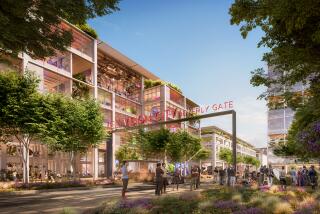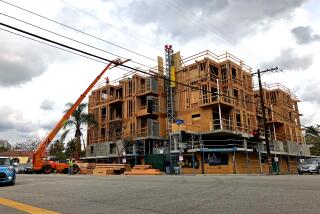Voters Will Be Asked to Ease Height Limits : Development: City and slow-growth advocates agree the curbs are too restrictive for construction of a shopping mall on Atlantic Boulevard. Issue could go to voters in April.
- Share via
Even some of the most ardent slow-growth advocates in Monterey Park agree that strict building height limits and other laws make it nearly impossible to build an attractive shopping mall.
So, with support from the Residents Assn. of Monterey Park (RAMP) and other longtime critics of development, the City Council on Monday tentatively approved a ballot measure asking voters to relax building standards along a portion of Atlantic Boulevard.
Existing standards for Atlantic Boulevard--adopted by voters in 1987--include a 50-foot height limit, even for lighting and flagpoles, and a requirement that developers terrace commercial buildings next to residential areas, in order to reduce bulk.
When they were adopted, the strict rules were believed necessary to control poorly planned development and to protect neighborhoods from overcrowding. But five years later, RAMP leaders and others who supported the rules concede they may be too strict.
They would pose serious obstacles, for example, to construction of a 400,000-square-foot enclosed shopping mall proposed for North Atlantic Boulevard.
“Because of past experiences that forced these standards into place, the people developing the standards did the best job they could,” said Verne Heitman, a city planning commissioner and member of RAMP. Heitman helped draft the 1987 rules.
“But you can’t foresee everything. We now have what appears to be a viable project and are proposing an amendment that will be an advantage, not a detriment,” he said.
If the rules aren’t changed, the proposed mall would look “just like any other mini-mall,” said Richard Myers, vice president of BCTC Development, which is building the $60-million project. The mall would have about 110 retail stores, possibly including an anchor department store and a movie theater.
Meanwhile, the city has postponed plans for a hotel next to the mall, after economic consultants warned of a sluggish hospitality industry.
Myers said the 50-foot height limit would not allow enough room for skylights in the three-story mall, a feature that would add natural lighting and a feeling of openness to the project. “Instead of looking up to a skylight, you’d be looking up to . . . blah,” he said.
If voters approve the changes, the maximum building height on both sides of Atlantic Boulevard between Hellman and Emerson avenues would be raised to 56 feet. Structures such as elevator towers, skylights, vents and handrails would be exempted from the 56-foot limit, provided they are not visible from street level.
Lighting and flagpoles on the roof, meanwhile, would be allowed even if they are visible from the street. In addition, the measure would no longer require a developer to terrace portions of a building that are next to the most densely zoned residential areas.
The ease with which the proposed measure passed Monday--no one in the audience spoke against it--underscores the extent to which BCTC has wooed the community, especially possible opponents.
BCTC’s president, Douglas Bao, has agreed to pay for legal and consulting fees for the project--normally a city expense. He also has bought most of the land with his own money, rather than depending on city Redevelopment Agency assistance.
“I think what you should be doing is working overtime to make it easier for the developer,” resident Phyllis Rabins told the council.
“This developer, unlike other businesses in the city, has gone out to talk to people,” said Andy Islas, who belongs to a neighborhood group protesting expansion of the Garfield Medical Center.
Recently, the hospital had to shorten light posts on the roof of its parking structure after Islas and others complained that the poles exceeded the height limit.
The council voted for the Atlantic Boulevard measure 4 to 0, with Mayor Sam Kiang absent. The council is expected to give final approval Wednesday to an election, possibly April 14, on the matter. It would require a majority vote to pass.
More to Read
Sign up for Essential California
The most important California stories and recommendations in your inbox every morning.
You may occasionally receive promotional content from the Los Angeles Times.










